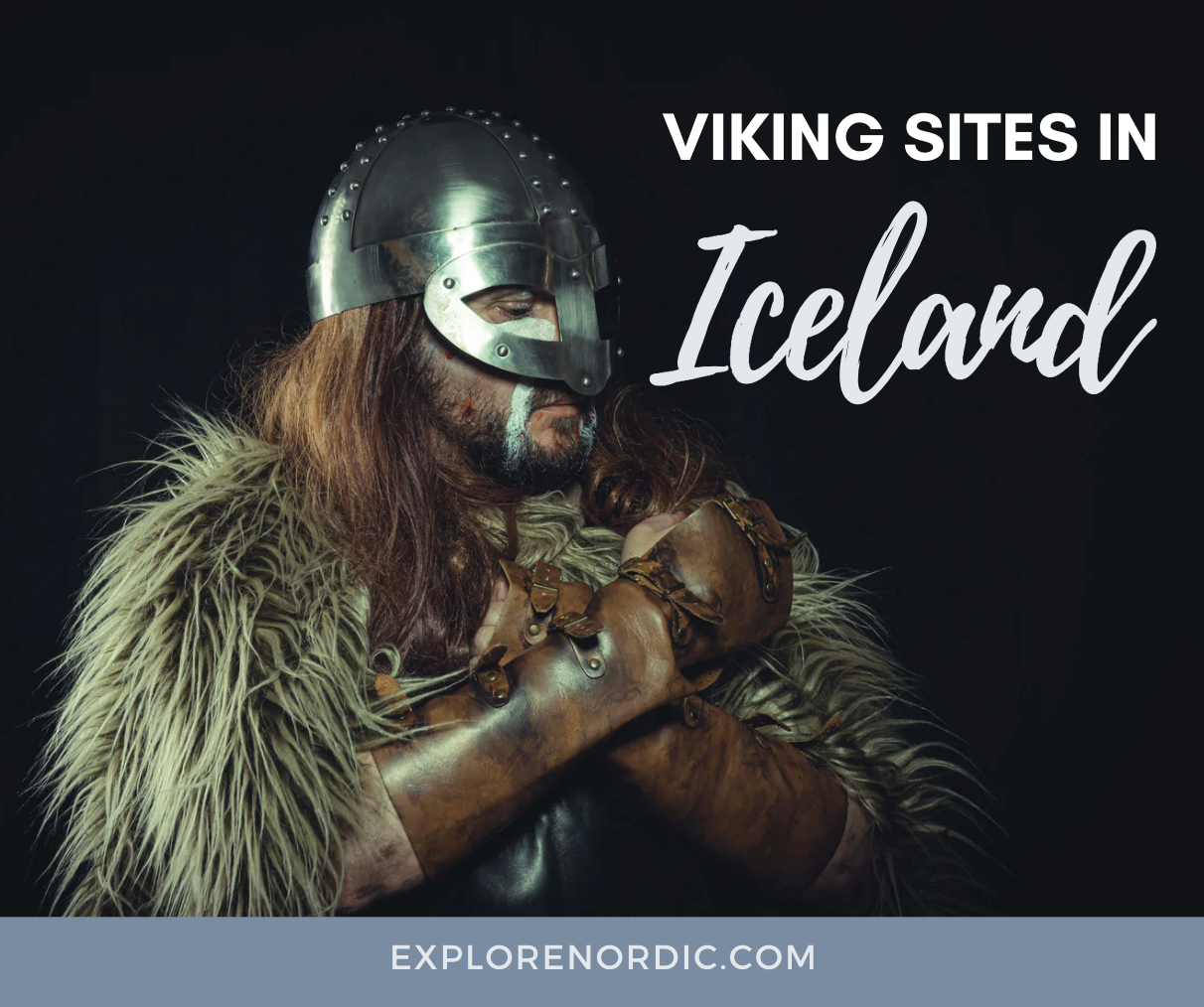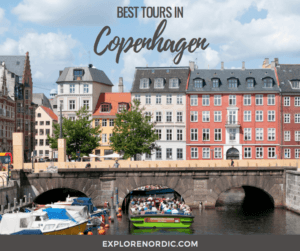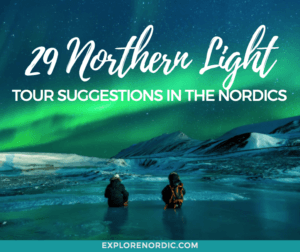Curious about Viking Sites in Iceland? Welcome, curious explorer, to the land where Vikings once roamed – Iceland, a realm of icy beauty and Viking lore that’s as captivating as the Northern Lights dancing across the Arctic skies. Let’s embark on a quest to uncover the fascinating world of Icelandic Vikings with a touch of informative magic.
Imagine this: Around the 9th century, when much of Europe was whispering tales of these legendary seafarers, Icelandic Vikings set their sights on the distant horizons. These intrepid souls weren’t just thrill-seekers; they were skillful navigators who sailed in their iconic longships, covering vast distances to raid, trade, and explore.
Icelandic Vikings in North America
Speaking of exploration, did you know that Icelandic Vikings ventured all the way to North America, long before Columbus claimed his fame? Leif Erikson, the adventurous son of Erik the Red, is said to have set foot on the shores of Vinland, which is believed to be present-day Newfoundland, Canada. That’s right – Viking longships graced North American shores around 500 years before Columbus even dreamt of crossing the Atlantic!
Viking Settlements Resourceful Farmers
Now, let’s dive into some chilly numbers. Picture this: The Icelandic Vikings were not just sailors; they were resourceful farmers who tamed the rugged landscape. Despite a relatively short growing season, they managed to cultivate barley, oats, and rye. Their livestock, including sheep and cattle, became essential for sustenance and trade. They even utilized geothermal energy to power mills, demonstrating their innovative spirit.
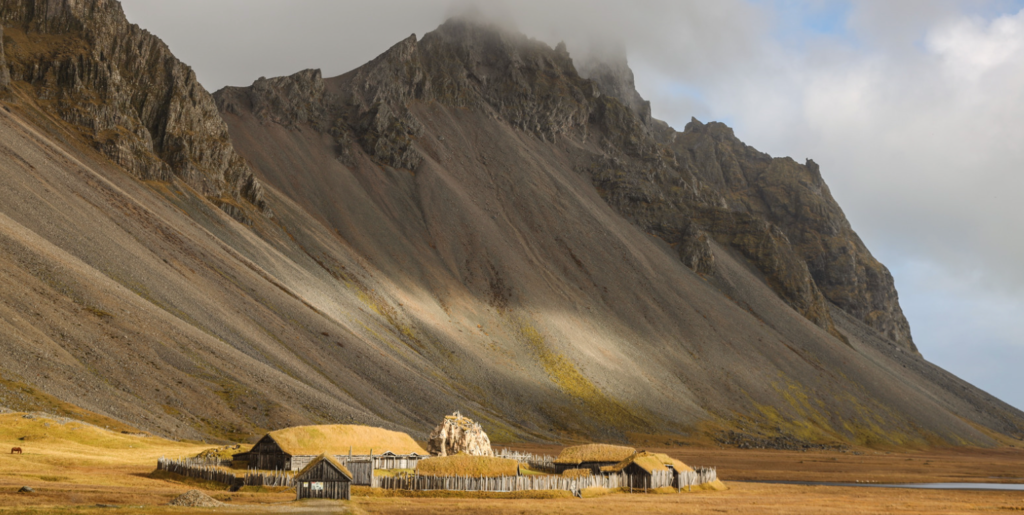
But it wasn’t all plough-shares and plowing fields. These Viking settlers faced the harsh realities of Iceland’s climate, navigating through volcanic eruptions, glacial rivers, and bone-chilling winters. Still, they persevered, building distinctive turf houses that provided insulation against the elements.
Speaking of settlements, let’s not forget the famous Alþingi – the world’s oldest parliament. Established in 930 AD, Vikings would gather annually at Þingvellir (Thingvellir) to discuss laws, resolve disputes, and forge alliances. This ancient assembly became a cornerstone of Icelandic democracy, laying the groundwork for modern governance.
Feasting Like a Viking
Now, picture yourself feasting like a Viking. Archaeological discoveries have revealed that Vikings in Iceland enjoyed a varied diet, from fish and seafood (thanks to the bountiful surrounding waters) to meats like lamb and even whales. They seasoned their meals with imported spices and enhanced their culinary artistry with dairy products, showcasing their ingenuity in the kitchen.
As you traverse the landscapes that once echoed with Viking tales, remember that the legacy of these explorers lives on in the very fabric of Iceland. From sagas to settlements, from feasts to farming, the Icelandic Vikings crafted a chapter of history that’s both daring and enduring. So, as you journey through this land of ice and fire, take a moment to salute those who once set sail and carved their mark into the heart of this captivating island. Skál
Exploring Icelandic Viking Sites
Iceland is home to a plethora of captivating Viking sites that offer a glimpse into the rich history and culture of the Norse seafarers. Here are some interesting Viking sites to visit in Iceland, along with sources for further information:
Þingvellir National Park, Þingvellir
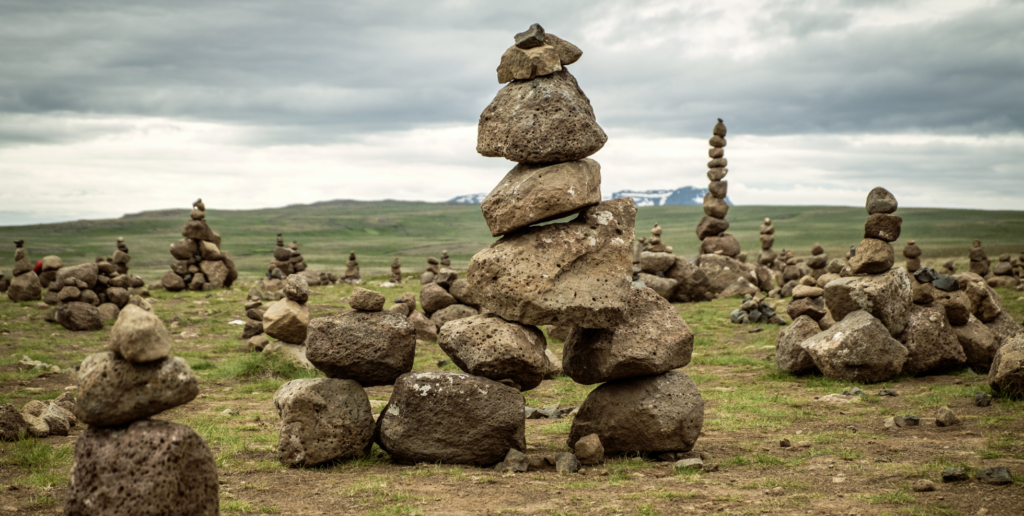
Þingvellir National Park (often referred to as Thingvellir National Park) is a UNESCO World Heritage site located in southwestern Iceland. This remarkable area holds immense historical, cultural, and geological significance, making it a must-visit destination for travelers seeking to delve into the heart of Iceland’s past and natural wonders.
Historical and Cultural Significance
Þingvellir was the site of the Alþingi, the Icelandic national assembly, which was established around 930 AD. This assembly was one of the earliest known parliaments in the world and played a pivotal role in shaping Iceland’s legal and political framework.
Lawmakers from various regions would gather annually at Þingvellir to discuss and pass laws, settle disputes, and engage in important social and political activities. The assembly’s meetings were held outdoors, often in a natural amphitheater formed by the surrounding cliffs.
The Almannagjá Rift and Lögberg
One of the most iconic features of Þingvellir is the Almannagjá rift, a dramatic fissure created by the separation of the North American and Eurasian tectonic plates. This geological marvel is part of the Mid-Atlantic Ridge and showcases the forces that have shaped Iceland’s landscape over millions of years.
Within the Almannagjá rift lies the Lögberg, or Law Rock, where the Lawspeaker would recite laws to the gathered assembly. This symbolic site holds historical significance as the place where laws were proclaimed, judgments were made, and legal matters were discussed in the presence of the nation.
Þingvellir’s Unique Natural Setting
Beyond its historical importance, Þingvellir National Park offers breathtaking natural beauty. The park is characterized by lush valleys, sparkling lakes, and dramatic lava fields. The Þingvallavatn Lake, which is the largest natural lake in Iceland, adds to the picturesque landscape. The park’s diverse flora and fauna thrive amidst this unique geological setting.
Diving into Silfra Fissure
For adventurous travelers, the Silfra Fissure within Þingvellir National Park offers a remarkable opportunity. Silfra is a freshwater fissure located between the North American and Eurasian tectonic plates. Divers and snorkelers can explore the crystal-clear waters, immersing themselves in a surreal underwater world with incredible visibility.
How to Visit
>Þingvellir National Park is easily accessible from Reykjavik, making it a popular day trip destination. Visitors can explore marked trails, visit the assembly site, and marvel at the geological wonders. Guided tours and informative signage provide insights into the park’s history, geology, and cultural importance.
Join a Tour:
Visiting Þingvellir National Park allows travelers to step back in time, stand upon ancient grounds where laws were established, and witness the forces that have shaped Iceland’s landscapes. It’s a true immersion into the heart of Iceland’s history and natural beauty.
Viking Site Iceland | Settlement Exhibition in Reykjavik
The Settlement Exhibition in Reykjavik offers a captivating journey into Iceland’s early history, providing visitors with a unique opportunity to explore the lives of the country’s first settlers and gain insights into their daily existence. Here’s a closer look at what the Settlement Exhibition has to offer:
Archaeological Discovery
The Settlement Exhibition is built around the remains of an actual Viking Age longhouse that was unearthed during archaeological excavations. This longhouse, dating back to the 10th century, serves as the centerpiece of the exhibition. As you step inside, you’ll find yourself transported to a bygone era, surrounded by the tangible remnants of a Viking household.
Life in a Viking Age Household
>The exhibition offers a vivid portrayal of the people who once inhabited the longhouse. Through interactive displays, artifacts, and multimedia presentations, visitors can gain a deeper understanding of the daily life, customs, and traditions of the Viking settlers. From household items and tools to decorative pieces and personal belongings, the artifacts provide a window into the past.
Recreating the Past
One of the highlights of the Settlement Exhibition is the meticulous reconstruction of a section of the longhouse. This allows visitors to visualize how the interior of a Viking-age dwelling might have appeared, from the layout of rooms to the arrangement of furniture and household items.
Multimedia Experience
The museum employs modern technology to enhance the visitor experience. Engaging multimedia presentations and audio guides provide additional context, offering insights into the historical context of the settlement era, the challenges the settlers faced, and the societal dynamics of the time.
Educational and Family-Friendly
The Settlement Exhibition is designed to be educational and family-friendly. It provides an immersive learning experience suitable for visitors of all ages. Interactive elements engage younger visitors, allowing them to step into the shoes of young settlers and experience the past firsthand.
Location and Accessibility
The museum’s location in downtown Reykjavik makes it easily accessible to tourists exploring the city. Its proximity to other attractions and amenities makes it a convenient stop for those interested in Icelandic history and culture.
The Settlement Exhibition offers a captivating blend of archaeology, history, and immersive experiences, allowing visitors to connect with Iceland’s Viking past on a personal level. It’s a place where the stories of the first settlers come to life, inviting you to explore the world they once inhabited and gain a deeper appreciation for the roots of Icelandic culture.
Viking World Museum, Reykjanesbær | Viking Sites in Iceland
 The Viking World Museum in Reykjanesbær offers an enchanting voyage into the world of the Vikings, providing visitors with a comprehensive and immersive experience that brings Iceland’s rich Viking heritage to life. It’s a small but mighty museum. Me and my family stopped here, having just a few hours in Iceland on a layover. Great stop if you have some time over. Here’s a closer look at what the Viking World Museum has to offer:
The Viking World Museum in Reykjanesbær offers an enchanting voyage into the world of the Vikings, providing visitors with a comprehensive and immersive experience that brings Iceland’s rich Viking heritage to life. It’s a small but mighty museum. Me and my family stopped here, having just a few hours in Iceland on a layover. Great stop if you have some time over. Here’s a closer look at what the Viking World Museum has to offer:
Gokstad Replica
One of the museum’s standout attractions is the full-scale replica of the Gokstad Viking ship, a meticulously crafted representation of the ship that was excavated from a burial mound in Norway. The ship showcases the remarkable craftsmanship and seafaring skills of the Vikings. Visitors can explore the ship’s interior, gaining insight into the challenges and adventures of Viking voyages.
Exhibition Halls
The Viking World Museum features exhibition halls that offer a diverse range of displays, artifacts, and multimedia presentations. These exhibitions cover various aspects of Viking life, including exploration, trade, warfare, and daily existence. Interactive elements engage visitors and provide an educational and entertaining experience.
Settlement Era Artifacts
Visitors have the opportunity to marvel at an array of Viking artifacts, including tools, weapons, jewelry, and household items. These artifacts provide a tangible connection to the daily lives of the Vikings and offer insights into their culture and technology.
Educational Programs
The museum offers educational programs and guided tours that cater to visitors of all ages. These programs provide deeper insights into Viking history, Norse mythology, and the maritime achievements of the Vikings. Educational workshops and demonstrations further enrich the visitor experience.
Café and Souvenir Shop
The museum features a café where visitors can relax, enjoy refreshments, and savor the Viking-inspired atmosphere. The souvenir shop offers a variety of Viking-themed items, including books, clothing, and handcrafted goods.
Location and Accessibility
The Viking World Museum’s location near Keflavík International Airport makes it a convenient stop for travelers arriving in or departing from Iceland. Its proximity to the Blue Lagoon and other attractions in the Reykjanes Peninsula also makes it an ideal addition to a day of exploration.
The Viking World Museum offers a captivating blend of history, art, and maritime heritage. It’s a place where visitors can step aboard a Viking ship, immerse themselves in Viking culture, and gain a deeper appreciation for the indomitable spirit of the Norse seafarers. Whether you’re a history enthusiast, a traveler seeking unique experiences, or a family looking for an educational adventure, the Viking World Museum is a destination that promises to leave a lasting impression.
Glaumbær Turf Farm, Skagafjörður | Viking Site Iceland
Yes, there is a connection between Glaumbær Turf Farm in Skagafjörður and the Vikings. While Glaumbær itself may not be directly linked to the Viking Age, it offers valuable insights into the historical and cultural context of the settlers who lived in the area, which includes the Viking Age. Here’s how the connection can be understood:
Historical Context
The Glaumbær Turf Farm provides a glimpse into the daily life and living conditions of Icelandic farmers during various periods, including the Viking Age. While the existing structures at Glaumbær primarily date back to the 18th century, the site offers valuable insights into the architectural techniques and lifestyle that evolved over the centuries, including during the Viking Age.
Continuity of Tradition
The turf house construction techniques that are showcased at Glaumbær have roots in traditional Icelandic architecture that can be traced back to the Viking Age. The use of turf, stones, and timber for building was a practice that had been employed by early settlers, including Vikings, as they adapted to the unique environmental conditions of Iceland.
Cultural Significance
Visiting Glaumbær can help visitors understand the continuity of cultural practices, including those that may have originated in the Viking Age. The site demonstrates how Icelanders adapted their architecture and way of life to the challenges posed by their environment, just as the Viking settlers had done.
While Glaumbær Turf Farm itself may not have direct Viking Age artifacts or structures, its portrayal of historical rural life offers valuable context for understanding the broader cultural heritage of Iceland, including the influence of Viking traditions. It provides an opportunity to connect with the past and gain a deeper appreciation for the resilience and resourcefulness of the people who inhabited the land, both during the Viking Age and beyond.
Skálholt, Southern Iceland | Viking Site in Iceland
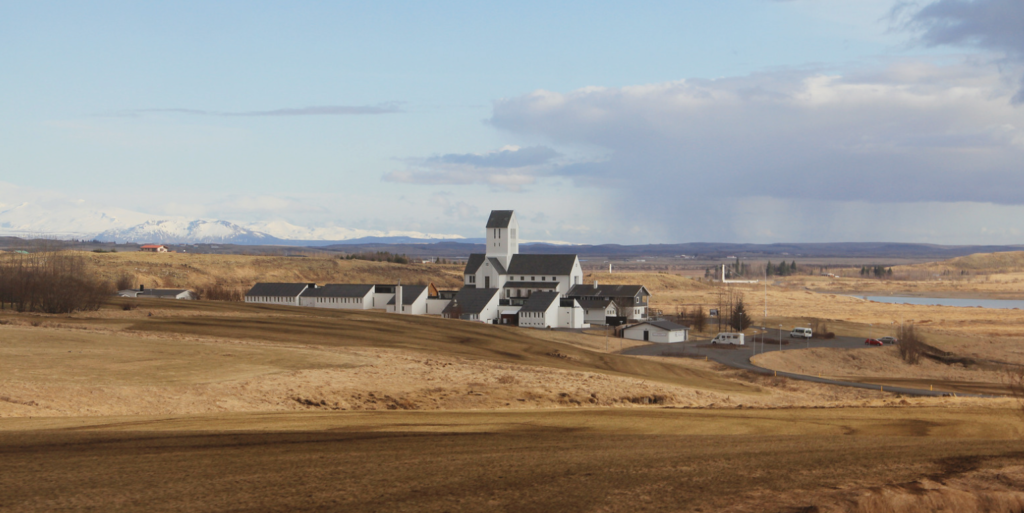
Skálholt, located in southern Iceland, holds a significant historical connection to the Viking Age and the subsequent development of Icelandic society. This historic site played a pivotal role in shaping the cultural, religious, and political landscape of the country. Here’s a closer look at Skálholt and its connection to the Vikings:
Early Settlement and Religious Center
Skálholt was settled in the early days of Iceland’s colonization, making it one of the country’s oldest inhabited areas. It became an important cultural and religious center, closely intertwined with the emergence of Christianity in Iceland. During the Viking Age, as Iceland transitioned from its pagan roots to Christianity, Skálholt played a central role in this transformation.
Bishopric and Educational Hub
In the 11th century, Skálholt became the seat of one of Iceland’s two bishoprics, the other being at Hólar. As a bishopric, Skálholt gained prominence as a center of religious authority, education, and governance. The establishment of a bishopric at Skálholt further solidified the transition to Christianity and marked an important chapter in Iceland’s history.
Influence on Icelandic Literature
Skálholt’s significance extended beyond religious matters. The site played a vital role in the development of Icelandic literature, particularly during the Middle Ages. Scholars at Skálholt contributed to the recording and preservation of Icelandic sagas and historical texts, which remain invaluable sources for understanding Viking Age culture, society, and events.
Architectural Legacy
Skálholt was home to notable buildings, including a cathedral that became an architectural and artistic masterpiece. The cathedral’s construction and renovation projects over the centuries reflect changing styles and influences, contributing to its cultural and historical significance.
Continued Importance of This Viking Site in Iceland
While Skálholt’s initial prominence waned over time, its historical and cultural importance endured. Today, the Skálholt Cathedral stands as a testament to the enduring legacy of this historic site. The cathedral continues to host religious services, events, and cultural activities, attracting visitors from around the world who seek to explore Iceland’s past and heritage.
Connection to Vikings
Skálholt’s connection to the Vikings lies in its role as a focal point of early Icelandic society, religious transformation, and cultural development during and after the Viking Age. The transition from paganism to Christianity, the preservation of sagas, and the establishment of a bishopric all mark Skálholt as a place where Viking traditions intersected with evolving cultural and religious influences.
Skálholt remains a symbol of Iceland’s historical journey, a place where the threads of Viking heritage, Christian transformation, and cultural evolution are woven together. It stands as a testament to the resilience and adaptability of the Icelandic people as they navigated the shifting tides of history and laid the foundations for the modern nation.
Viking Sites in Iceland | Eiríksstaðir, Haukadalur Valley
Eiríksstaðir, situated in Haukadalur Valley, is a historically significant site in Iceland that is closely associated with the Viking Age and the legendary figure Erik the Red. This site provides a fascinating glimpse into the life and adventures of one of the most prominent Viking explorers. Here’s an exploration of Eiríksstaðir and its connection to the Vikings:
Erik the Red
Erik the Red, also known as Eiríkur rauði in Old Norse, was a Viking explorer and chieftain. He is perhaps best known for his pivotal role in the exploration and settlement of Greenland, making him a central figure in Norse exploration during the Viking Age.
Settlement and Homestead
Eiríksstaðir is believed to have been the homestead of Erik the Red and his family. This historic farmstead offers visitors a unique opportunity to step into the world of Erik the Red and gain insights into his life, achievements, and the challenges he faced.
Replica of Erik’s Longhouse
One of the highlights of Eiríksstaðir is the meticulously reconstructed longhouse, a replica of the type of dwelling Erik the Red would have inhabited. The longhouse provides a tangible link to the past, allowing visitors to experience firsthand the architectural style and living conditions of Viking settlers.
Living History and Exhibitions
Eiríksstaðir offers more than just a physical reconstruction. The site provides living history demonstrations and exhibits that delve into various aspects of Viking life, including crafting, cooking, and daily activities. These interactive elements bring the past to life, helping visitors immerse themselves in the world of the Vikings.
Erik’s Legacy
Erik the Red’s legacy extends beyond his explorations. He was the father of Leif Erikson, who is believed to have been the first European to reach North America, predating Christopher Columbus. The Erikson family’s connection to both Greenland and Vinland (North America) showcases their pivotal role in Viking voyages and their impact on world history.
Scenic Surroundings
Eiríksstaðir is situated in the picturesque Haukadalur Valley, surrounded by the stunning landscapes that make Iceland a unique and captivating destination. The natural beauty of the area enhances the visitor experience, providing a serene backdrop to the historical site.
Eiríksstaðir offers a journey through time, allowing visitors to connect with the spirit of Viking exploration and adventure. It’s a place where history comes alive, offering a glimpse into the past and a deeper understanding of the individuals who shaped the course of Viking history. Whether you’re intrigued by Norse sagas, Viking voyages, or the remarkable achievements of Erik the Red, Eiríksstaðir is a destination that offers both education and inspiration.
These Viking sites in Iceland offer a captivating journey into the past, allowing you to explore the Viking legacy, architecture, and maritime achievements. Enjoy your exploration of these historically rich destinations!
Source:
Reykjavik City Museum. (n.d.). “The Settlement Exhibition.” https://reykjavikcitymuseum.is/museum/the-settlement-exhibition
Viking World Museum. (n.d.). “Viking World Museum.” https://vikingworld.is/
Eiríksstaðir. (n.d.). “Eiríksstaðir.” <https://eiriksstadir.is/


